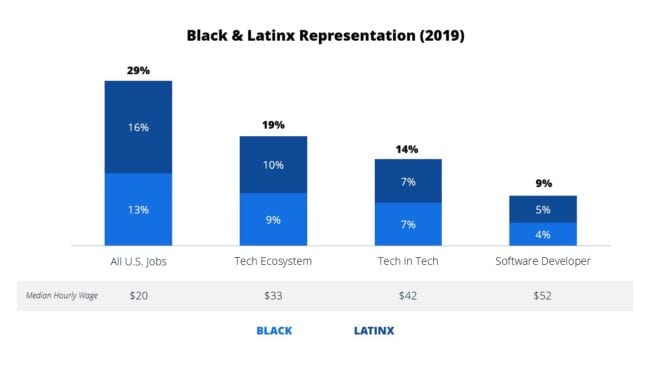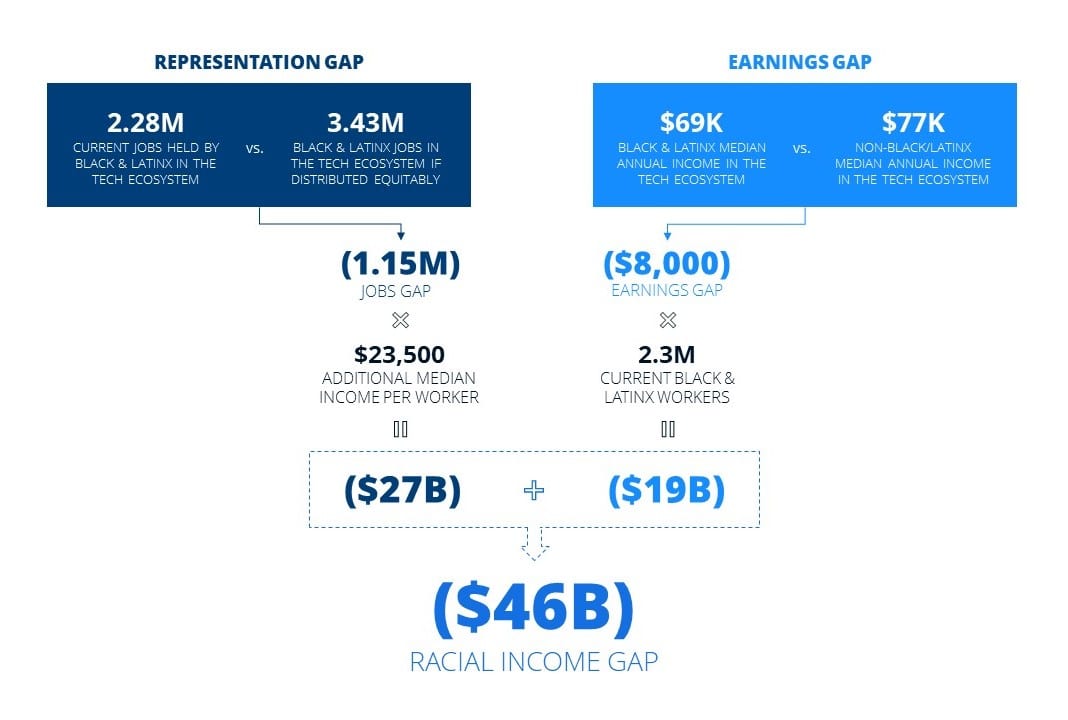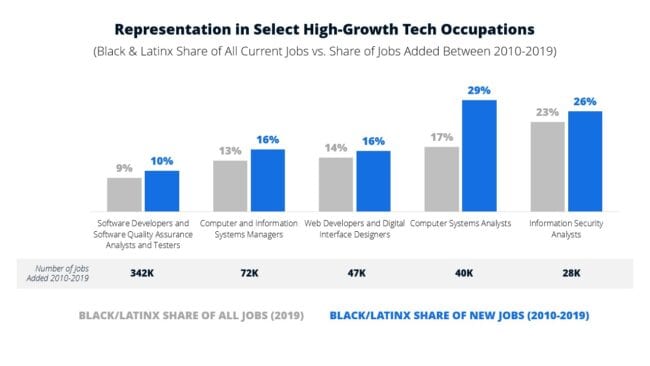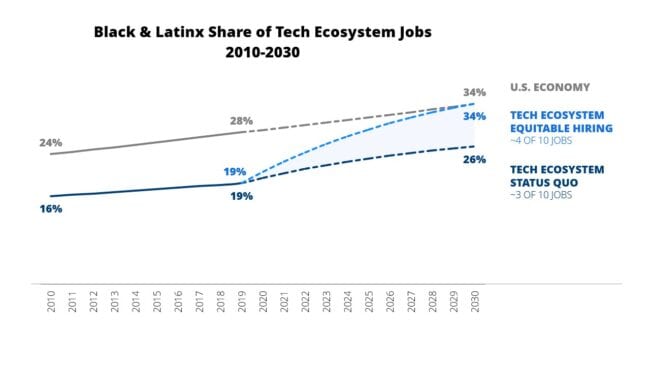on Apr 23, 2021
Tech’s racial equity gap costs Black & Latinx workers $50B a year. Our collaborators prescribe solutions.
Written by Kate Wittels, Shuprotim Bhaumik, Bret Nolan Collazzi, and Ashley So
When HR&A released its first major tech ecosystem study in 2014, we were struck by the immense opportunity for economic mobility: unlike other growing, well-paying segments of the economy, many tech jobs did not require a formal degree or prior job experience, and, better still, those same jobs paid well above a living wage. Here was a sector the rapid growth of which could benefit a broad spectrum of workers and help narrow racial income and wealth gaps.
Since then, we’ve worked with clients across the U.S. to try to leverage tech for opportunity, helping the City University of New York strengthen industry partnerships, promoting skills-based hiring through the Skillful Initiative, and working with innovation districts to promote equitable hiring and startup support, among other strategies. Countless other advocates, educators, nonprofits, government agencies, and tech employers have done more, pioneering new approaches to skills training, startup support, and culture change.
Yet today, tech’s racial equity crisis is as deep as ever. Black and Latinx workers are grossly underrepresented across tech, as detailed in our recent study of New York City’s tech ecosystem with Jobs for the Future, LaGuardia Community College, and NYCEDC. Black and Latinx tech workers report exhausting and racist workplaces. Most venture funding flows to White males, who dominate leadership positions. These disparities not only have implications for income and wealth equity, but the absence of Black and Latinx workers on tech teams also reinforces structural racism, as shown by bias in facial recognition software and algorithms for search, health care, and hiring.
Closing tech’s equity gap will take bolder action than we’ve seen to date. We are seeking to support change in two ways:
- Equip tech equity champions with data that demonstrates the size of tech’s racial income gap and the costs of inaction. The analysis below is a start.
- Collaborate with industry experts, advocates, and policymakers to use the data to inform efforts to narrow the racial income gap and promote greater accountability for action. We began by inviting partners in our network to share their ideas here. Let us know how you could use this data and what questions and ideas you have at justandresilient@hraadvisors.com.
The scale of tech’s racial income gap
Over the last decade, the national tech ecosystem grew 60% faster than the economy as a whole and now represents 12 million total jobs.1 From 2010 to 2019, tech represented 11% of new jobs and 13% of new income across the U.S.
However while Black and Latinx workers make up 29% of U.S. workers, they make up only 19% of the tech ecosystem.2 When you look solely at tech occupations at tech companies – the highest-paid and fastest-growing positions in the ecosystem – the gap grows; Black and Latinx workers make up only 14% of jobs overall and 9% of developer jobs. Big Tech performs even worse: Black and Latinx representation across all jobs in these companies is as low as 10% at Google and Facebook.

The result of these disparities is an estimated $46 billion “racial income gap,” consisting of:

Despite widespread diversity commitments and a robust tech training ecosystem, hiring over the last decade for the highest-growth tech jobs has continued to underrepresent Black and Latinx candidates, with the share of Black and Latinx new hires only slightly outpacing their share of current jobs. Among the three occupations that added the most positions since 2010, the Black and Latinx share of new hires remains well below the overall workforce. Two bright spots are systems analysts and cybersecurity jobs, where the Black and Latinx share of new hires meets or nearly meets their share of the overall workforce, potentially owing to inclusive hiring efforts focused on these skills.

Given these trends, the racial income gap has actually widened slightly over the past decade as the overall workforce has grown more diverse. If tech hiring continues on the same trajectory as in recent years, tech’s representation gap will continue to grow over the next 10 years. To eliminate this gap within 10 years, tech employers would need to hire Black and Latinx candidates for at least 2 out of every 5 open tech positions, versus 1 out of 5 today overall and 1 out of 7 for core tech occupations.

Research debunks the oft-cited view that the root of the problem is the talent pipeline; 20% of computer science graduates are Black or Latinx, well above their share of tech positions (14%), especially at Big Tech firms (<10%). To meaningfully address tech’s racial income gap, employers will need to not only rethink their hiring practices but also look to aspects of company culture that limit the advancement of Black and Latinx recruits, rethink the recruitment practices that pass over Black and Latinx talent, and invest more deeply in new models to train and onboard talent from more diverse channels.to train and onboard talent from more diverse channels.
Where to go from here
At stake is not only billions of dollars of annual income that could help mitigate deep racial wealth disparities, but also the full participation by Black and Latinx Americans in a democracy that is increasingly tied to who makes, uses, and controls the tools of the 21st century.
How can we meaningfully build greater equity in tech? Read more for initial thoughts on how leading tech equity organizations plan to use the above data for change, sourced from across industry, advocacy, and policy. And let us know your thoughts at justandresilient@hraadvisors.com.
1 We define the “tech ecosystem” as all jobs at tech companies, whether a software developer or an HR manager at Google, and all tech jobs in non-tech industries, such as a software developer for a bank or PR firm.
2 This gap is wider if we compare the makeup of tech jobs to that of the working-age population, since Black and Latinx workers have above-average unemployment rates and below-average labor force participation rates.